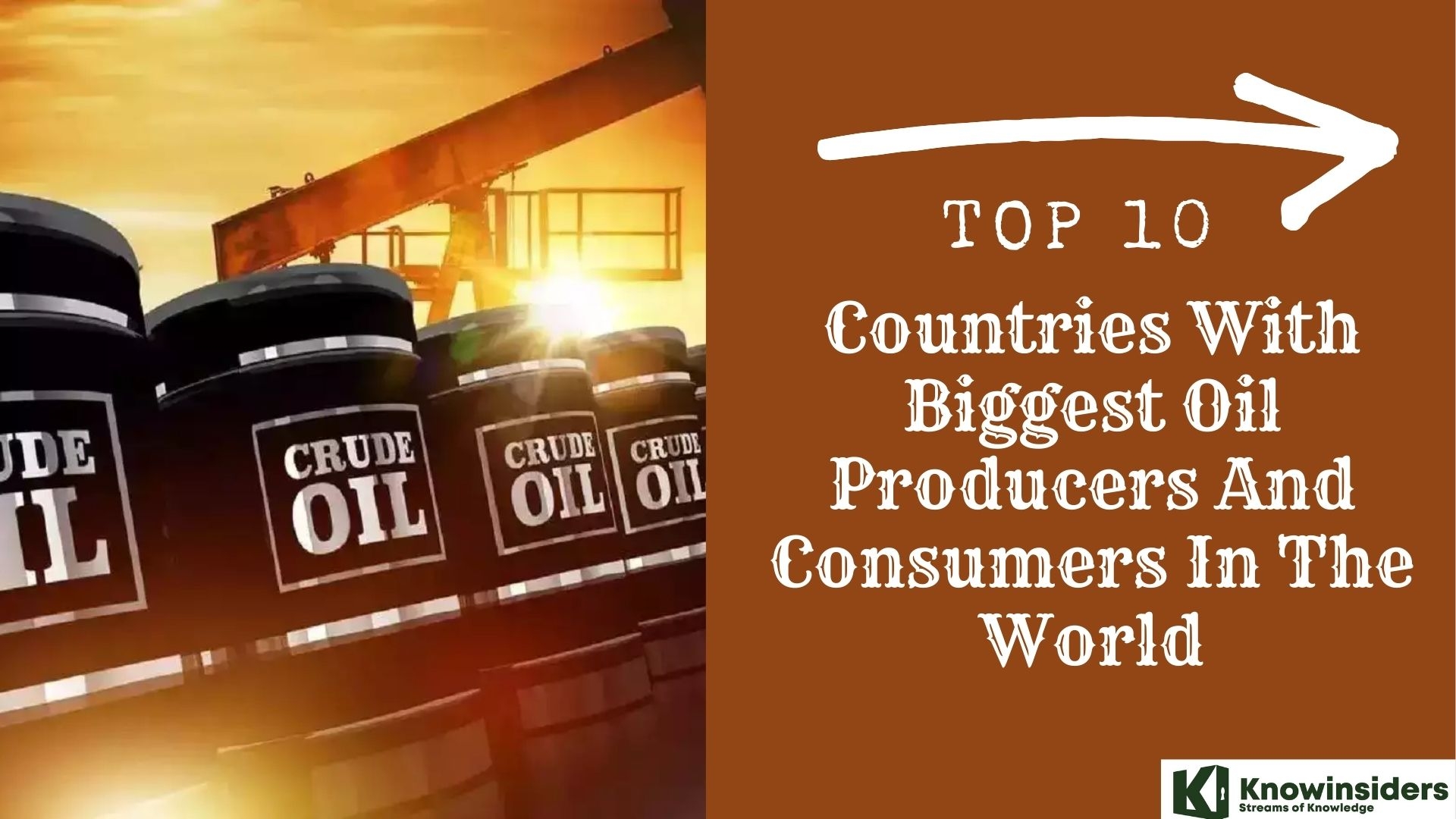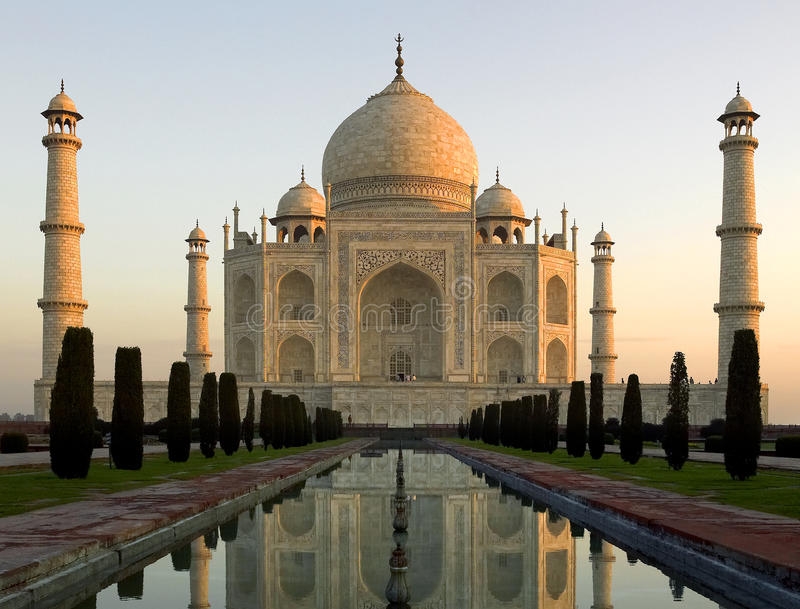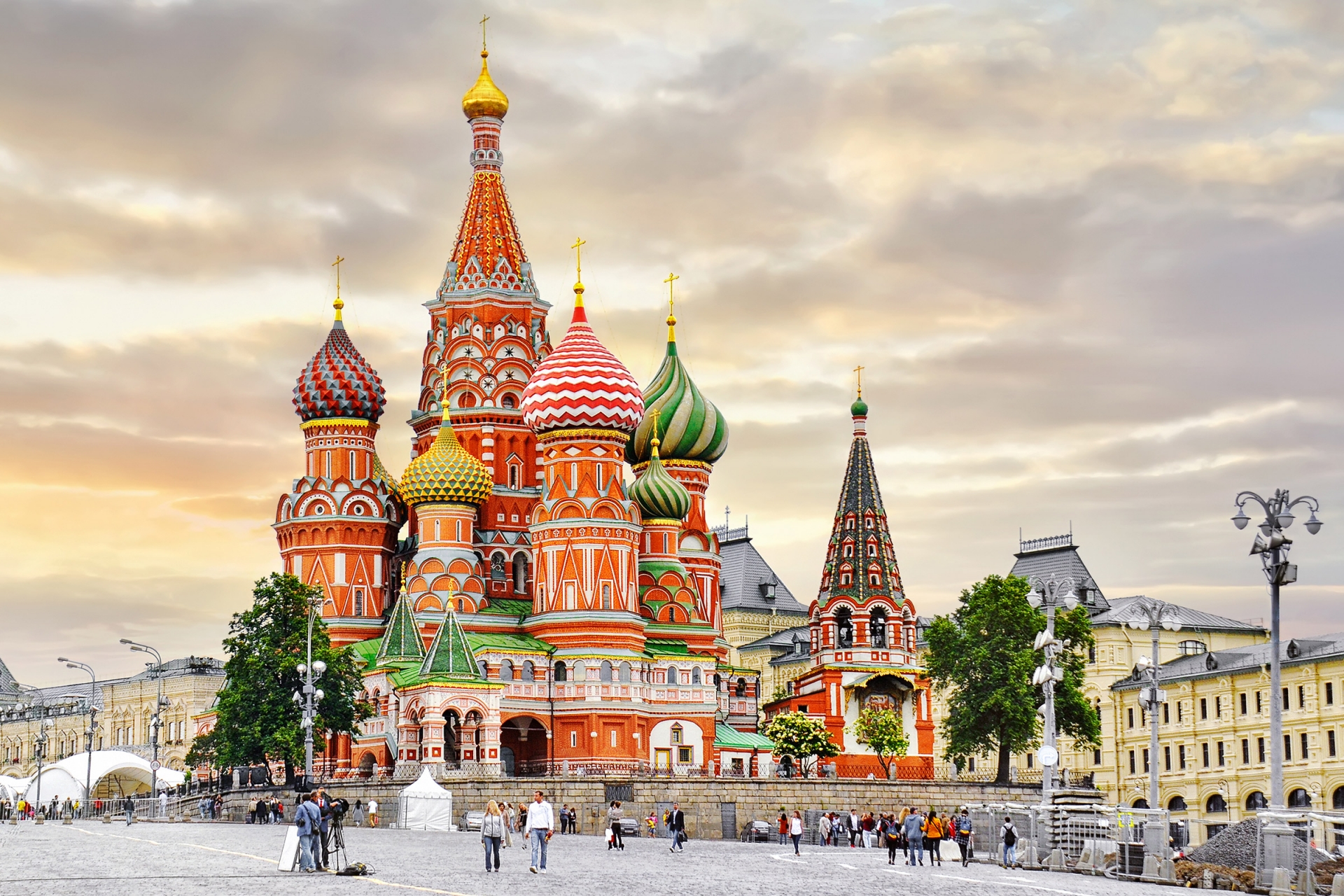Top 10 Countries With Biggest Oil Producers And Consumers In The World
 |
| Top 10 Countries With Biggest Oil Producers And Consumers In The World |
| Table of Content |
Oil generates revenue for countries with enough oil reserves to produce more oil than they consume. And for those economies that are heavily dependent on imports, oil expenditures must be factored into national budgets. Not surprisingly, events such as unrest in oil-producing regions, new oil field discoveries, and advances in extraction technology profoundly affect the oil industry. Most of the time, the top oil-producing countries in the world rake in a lot of profit on their production.
Global production of oil and other petroleum liquids averaged 95.6 million barrels per day (b/d) in 2021, according to the U.S. Energy Information Administration (EIA).1 In 2021, the top producing country group was OPEC (31.7 million b/d) followed by OECD (31.0 million b/d) (some countries are in both groups, such as the United States). The top three producing countries identified by the EIA in 2021 were the United States (18.9 million b/d), Saudi Arabia (10.8 million b/d), and Russia (10.8 million b/d).
Here are the top 10 countries with biggest oil producers and consumers in the world.
Why oil is important to the economy?
The oil and gas industry has both a direct and indirect impact on the domestic economy, with oil and gas prices directly affecting the health of the economy as a whole. Oil and gas is incredibly important not only to individuals and businesses within the United States, but also to the position of the United States among other countries across the globe. In order to protect the United States economy, the oil and gas industry will need to thrive.
Oil is the Major Energy Source Throughout the World
Oil and natural gas combined provide over half of the world’s energy. Oil and natural gas are necessary resources. A lack of oil and natural gas would have the country (and the world) grinding to a halt. Though there have been “renewable” and “sustainable” energy initiatives, none of them have been able to contribute a significant amount of energy to the world. They have either been prohibitively expensive, difficult, or simply unreliable. Oil and natural gas runs the world, and without it many countries would not be able to sustain their daily operations. This includes the United States.
Domestic Oil and Gas Production is Required for Energy Independence
Without the production of oil and natural gas in the United States, the United States would quickly become dependent on foreign supply. And once that occurred, the domestic economy would be controlled directly through the price of oil and gas exports. This has historically been the case before hydraulic fracturing led to the country’s energy independence. Oil has been largely controlled by OPEC, a conglomerate of oil-producing countries that have collaborated to “price fix” the oil industry for some time. The energy industry has been disrupted via shale oil through fracking, thereby stripping OPEC of much of its power over the US economy.
Cheap Oil and Gas Prices Improve the United States Economy
The oil and gas industry has improved the economic outlook for the United States in two major ways. The health of the oil and gas industry has allowed the United States to begin exporting crude oil and natural gas rather than importing it, creating an energy market that will bring money into the country rather than sending money out of the country. This is critical, as many other industries (such as manufacturing) have been moving out of the United States. Equally importantly, the oil and gas industry has been able to achieve profitable margins without significantly increasing the cost of oil and natural gas. This is very important because it leads to lower gasoline and energy costs for the average American. When Americans spend less on utilities and gasoline, they begin to spend more at their local businesses. Lower gas and utility prices mean cheaper goods, cheaper shipping, and cheaper transportation altogether. The health of the American economy has always been directly associated with low gas prices.
List of Top 10 Countries With Biggest Oil Producers In The World
| Country | Million barrels per day | Share of world total |
| United States | 20.54 | 20% |
| China | 14.01 | 14% |
| India | 4.92 | 5% |
| Japan | 3.74 | 4% |
| Russia | 3.70 | 4% |
| Saudi Arabia | 3.18 | 3% |
| Brazil | 3.14 | 3% |
| Canada | 2.63 | 3% |
| South Korea | 2.60 | 3% |
| Germany | 2.35 | 2% |
| Total top 10 | 60.81 | 61% |
Source: International Energy Statistics, Total oil (petroleum and other liquids) production, as of May 10, 2022
1. United States
 |
| Photo: Unsplash |
The United States holds 35,230,000,000 barrels of proven oil reserves as of 2016, ranking 11th in the world and accounting for about 2.1% of the world's total oil reserves of 1,650,585,140,000 barrels.
The United States has proven reserves equivalent to 4.9 times its annual consumption. This means that, without imports, there would be about 5 years of oil left (at current consumption levels and excluding unproven reserves).
The largest economy in the world, the U.S. is also the largest producer of oil. The U.S. crude oil production exceeded that of Saudi Arabia in 2018 after more than two decades and has maintained the lead since then. Crude oil is produced in 32 U.S. states and in coastal waters. However, close to 71% of the total U.S. crude oil production comes from five states—Texas, North Dakota, New Mexico, Oklahoma, and Colorado. America’s oil and natural gas industry supports 10.3 million jobs in the country and contributes nearly 8% of its gross domestic product (GDP).
The data by U.S. Energy Information Administration (EIA) indicates that total petroleum production in the U.S. averaged about 18.87 million b/d while its consumption averaged about 19.78 million b/d in 2021. The difference between consumption and production is by imports. The top five source countries of U.S. gross petroleum imports in 2021 were Canada, Mexico, Russia, Saudi Arabia and Colombia.
Oil Imports
The United States imports 37% of its oil consumption (7,259,000 barrels per day in 2016).
2. China
 |
| Photo: iStock |
The impact of the petroleum industry in China has been increasing globally as China ranks seventh for oil production and second in crude oil consumption in the world.
China imported a record 6.7m barrels a day (b/d) of oil in 2015 and was forecast "to overtake the U.S. as the world’s biggest crude importer in 2016"
China produced 5.0 million b/d of petroleum liquids in 2021, accounting for 5% of the world’s production.2 China passed the U.S. to became the world's largest oil importer in 2017.19 China's oil consumption of 14.0 million b/d in 2019 made it the world's second-largest consumer in the world after the U.S.2
The northeast and north-central regions of the country are responsible for the majority of domestic production. Mature fields like Daqing have been heavily drilled for oil since the 1960s, and companies are increasingly investing in enhanced oil recovery (EOR) techniques, such as polymer and stream flooding and water injection, to offset some of the production declines.
This shift to dependence on foreign oil has changed the exploration and acquisition policies of China. China's oil need overwhelmed its internal capabilities.
China National Offshore Oil Corp, China National Petroleum Corp, and Sinopec have largely invested in exploration and development in countries that had oil fields but do not have funds or technology to develop them. In 2004 CNOOC signed a deal to extract a million barrels of oil a day in Indonesia as well as other projects with Australia. In addition, an oil reserve that would theoretically fill with 30 days worth of oil has begun construction in China. However, their oil policy on the world oil market was not completely clear as to how they would deal with the situation as a whole.
The Chinese government is taking diplomatic action to improve their relationship with ASEAN states. According to a 2008 report, the Chinese government had to take extra strides to secure good relationships with its neighbors. Malaysia is a neighbor state that was often seen as in contention with China because of political differences. Yet, the relationship with Malaysia was symbiotic because of their large supply of oil and their need for security assurances from China. In 2008 Malaysia was the number one producer of petroleum in the South China Sea, and they account for over one half of the production in the region.
3. India
 |
| Photo: Dreamstimes |
India holds 4,728,790,000 barrels of proven oil reserves as of 2016, ranking 24th in the world and accounting for about 0.3% of the world's total oil reserves of 1,650,585,140,000 barrels.
India has proven reserves equivalent to 2.9 times its annual consumption. This means that, without imports, there would be about 3 years of oil left (at current consumption levels and excluding unproven reserves).
India produces 1,016,370.64 barrels per day of oil (as of 2016) ranking 20th in the world.
India produces every year an amount equivalent to 7.8% of its total proven reserves (as of 2016).
India consumes 4,443,000 barrels per day (B/d) of oil as of the year 2016.
India ranks 3rd in the world for oil consumption, accounting for about 4.6% of the world's total consumption of 97,103,871 barrels per day.
India consumes 0.14 gallons of oil per capita every day (based on the 2016 population of 1,324,517,249 people), or 51 gallons per capita per year (1 barrels). [1 barrel = 42 US Gallons]
The oil and gas industry in India dates back to 1889 when the first oil deposits in the country were discovered near the town of Digboi in the state of Assam. The natural gas industry in India began in the 1960s with the discovery of gas fields in Assam and Maharashtra (Mumbai High Field). As on 31 March 2018, India had estimated crude oil reserves of 594.49 million tonnes (MT) and natural gas reserves of 1339.57 billion cubic meters (BCM).
India imports 82% of its oil needs and aims to bring that down to 67% by 2022 by replacing it with local exploration, renewable energy and indigenous ethanol fuel. India was the second top net crude oil (including crude oil products) importer of 205.3 Mt in 2019.
By March 2021, India’s domestic crude oil production output fell by 5.2% and natural gas production by 8.1% in the FY21 as producers extracted 30,491.7 Thousand Metric Tonnes (TMT) of crude oil and 28670.6 Million Metric Standard Cubic Metres (MMSCM) of natural gas in the fiscal. In August 2021, crude oil production decreased by 2.3%, but there was a 20.23% increase in homegrown natural gas.
4. Japan
 |
| Photo: Getty Images |
Japan holds 44,115,000 barrels of proven oil reserves as of 2016, ranking 78th in the world and accounting for about 0.0% of the world's total oil reserves of 1,650,585,140,000 barrels.
Total Oil Reserves in Japan are less than even a single year of oil consumption (1,464,700,123 barrels as of 2016), making Japan highly dependent on oil imports in order to substain its consumption levels.
Japan consumes 4,012,877 barrels per day (B/d) of oil as of the year 2016.
Japan ranks 4th in the world for oil consumption, accounting for about 4.1% of the world's total consumption of 97,103,871 barrels per day.
Japan consumes 1.32 gallons of oil per capita every day (based on the 2016 population of 127,763,265 people), or 481 gallons per capita per year (11 barrels). [1 barrel = 42 US Gallons]
Japan produces 123,525.03 barrels per day of oil (as of 2016) ranking 44th in the world.
Japan produces every year an amount equivalent to 102.2% of its total proven reserves (as of 2016).
In the wake of the two oil crises of the 1970s (1973 and 1979), Japan made efforts to diversify energy resources in order to increase security. Japan's domestic oil consumption dropped slightly, from around 5.1 million barrels (810,000 m3) of oil per day in the late 1980s to 4.9 million barrels (780,000 m3) per day in 1990. While the country's use of oil declined, its use of nuclear power and Natural gas rose substantially. Several Japanese industries, for example electric power companies and steelmakers, switched from petroleum to coal, most of which is imported. Japan's proved oil reserves total an estimated 44 million barrels.
The state stockpile equals about 92 days of consumption and the privately held stockpiles equal another 77 days of consumption for a total of 169 days or 579 million barrels (92,100,000 m3). The Japanese SPR is run by the Japan Oil, Gas and Metals National Corporation. Japan was the fifth-largest oil consumer and fourth-largest crude oil importer in the world in 2019.
Oil demand has been waning in Japan, especially leading up to and since the Tohoku earthquake in 2011. While oil consumption was over 5 million barrels per day (bpd) for decades, this had declined to 3.22 million bpd by 2017. As of 2016, India, Saudi Arabia and Texas have overtaken Japan in oil consumption. A further decline to 3.03 mln bpd or just under 176 million kiloliters (preliminary) was posted in 2018. Crude consumption further declined during first half of 2020 to 303/141 = 2.15 million bpd, but that figure probably doesn't include refined products that are directly increasingly imported rather than converted.
5. Russia
 |
| Photo: Getty Images |
Russia is the third largest producer of oil in the world behind the United States and Saudi Arabia. Russia’s total oil production was 11.3 million b/d in January 2022, according to the IEA.
Russia has been actively coordinating oil production with OPEC and other non-OPEC producers, collectively known as the OPEC+ agreement. About 60% of Russia’s oil exports go to OECD Europe. China is the largest single buyer of Russian oil (20% of Russia’s exports)—averaging at 1.6 million b/d of crude in 2021, equally divided between pipeline and seaborne routes.
In the wake of the Russia-Ukraine crisis, the U.S. placed a ban on the import of Russian crude oil and certain petroleum products, liquefied natural gas and coal. In 2021, the U.S. imported nearly 700,000 barrels per day of crude oil and refined petroleum products from Russia. The country’s oil production is mainly controlled by domestic companies such as Rosneft, Lukoil, Surgutneftegas, Gazprom and Tatneft. Oil is an integral part of Russia’s economy.
Russia was one of the world’s top oil producers with an average of 10.8 million b/d in 2021, accounting for 11% of global production.
Russia’s main regions of oil production are Western Siberia, Urals-Volga, Eastern Siberia and the Far East. Most of the production originates from the West Siberia and Volga-Urals regions, especially the Priobskoye and Samotlorskoye fields in Western Siberia.
The oil industry in Russia was privatized after the fall of the Soviet Union, but the state has since forced a consolidation and a restructure in 2001. Gazprom, Rosneft and Lukoil are the top Russian oil and gas producers.
6. Saudi Arabia
 |
| Photo: Getty Images |
Saudi Arabia, officially the Kingdom of Saudi Arabia, has 17% of the world’s proven crude oil reserves, second largest in the world. Saudi Arabia is a founder member of OPEC and contributes 22.4% of its current share. It joined the World Trade Organization in 2005 to gain access to global markets, create jobs and encourage foreign investment. Around 50% of its GDP and 70% of Saudi Arabia’s export earnings are governed by the oil and gas sector.
In 2020, Saudi Arabia reduced production to rebalance the global oil market in sync with the decision taken by OPEC. During 2018, 2019 and 2020, the country produced 12.11, 11.47 and 10.85 million b/d of petroleum and other liquids. According to EIA, Saudi Arabia increased production since February 2021, and by October, it reached an estimated 9.8 million b/d. As per the International Energy Agency (IEA), Saudi Arabia’s total oil production was 12 million b/d in January 2022. Saudi Arabia domiciled Aramco is among the most valued companies in the world.
Saudi Arabia contributed 10.8 million b/d, representing 11% of the world’s total petroleum liquids production in 2021.2 It held 15% of the world's proved oil reserves and was the largest crude exporter in 2020.11 Saudi Arabia is the only member of the Organization of the Petroleum Exporting Countries (OPEC) to make this list.
According to the CIA World Factbook, the petroleum sector accounts for roughly 42% of the country’s gross domestic product (GDP), 87% of its budget revenues, and 90% of export earnings.13 Saudi Arabia’s major oil fields include Ghawar, Safaniya, Khurais, Manifa, Shaybah, Qatif, Khursaniyah, Zuluf, and Abqaiq.
Important: Global crude (includes lease and plant condensate) oil production is expected to rise from 76.1 million b/d in 2020 to 99.3 million b/d in 2050. Total petroleum liquids production is seen rising from 94 million b/d to 125.9 million b/d over the same time frame.
7. Brazil
Brazil is the largest oil producer in South America, the eighth largest global oil producer, eighth largest oil consumer, and has the largest recoverable ultra-deep oil reserves in the world. Brazil’s oil production is predominantly offshore (96.7 percent), with the national oil company Petrobras accounting for 73 percent of Brazil’s oil and gas production. The oil and gas market has, for years, accounted for most investments in the Brazilian economy, with about 10% of the country’s GDP. Brazil is placed in a leading position for the exploration and production of offshore oil due to owning the prolific pre-salt province, whose oil is of high quality, with equally high productivity of the fields. The International Energy Agency (IEA) highlights the relevance of Brazil, which will become responsible for the production of about 50% of the world’s offshore oil in 2040, about 5.2 million barrels/day.
Significant energy reforms, frequent oil finds, along with recent and future oil bidding rounds have been attracting International Oil Companies (IOCs) from around the world to bid on opportunities in Brazil. Furthermore, some international companies have also started to show interest and invest in the Brazilian downstream subsector through the acquisition of gas pipeline networks and the construction of liquified natural gas terminals. There is an increased potential for U.S. exports of equipment and services, with lower local content requirements. Brazil´s 2021-2030 Energy Expansion Plan (PDE) forecasts that oil and gas exploration and production (E&P) investments will range from US$ 415 billion to US$ 454 billion during this period. These figures reflect an evaluation of aggregated investments of all E&P in Brazil, including those from national oil company Petrobras.
Oil Exploration and Production: Brazil is Latin America´s top oil producer, and has surpassed Mexico and Venezuela. The 2020 average oil production was 2.94 million barrels per day according to the Brazilian National Oil and Gas (ANP) data. Brazil’s 2020 natural gas production amounted to 127 million cubic meters/day - up 4.1% in relation to 2019. The domestic oil production growth, especially since 2013, was mainly due to the pre-salt Santos Basin´s high productivity, which relied on oil outputs per well above the global oil industry´s average. This high reservoir productivity has required fewer wells per production system, reducing budgeted costs.
Pre-salt continues to attract most investments, and its production already accounts for more than 60% of the national production. The rapid rise in production was enabled by the aforementioned productivity, but was also supported by high drilling success rates. Likewise, continued investments in new technologies have improved well construction efficiencies, which reduced drilling and completion times. The combination of these factors allowed a 61% fall in well lifting costs from 2014 to 2021 from US$ 15.3 per barrel to US$6.66, for non-pre-salt fields, and to about US$4.35 for pre-salt ones.
The 2020 ANP data shows that Brazil´s proven natural gas reserves reached 338 billion cubic meters, making Brazil rank 33rd in world proven gas reserves. Associated gas currently represents approximately 80% of Brazil’s natural gas production, which is expected to reach its peak production of 183 million m³/day by 2028.
In 2020, on the supply side, domestic gas production accounted for 58%, while imports from Bolivia represented 23%, followed by LNG imports (20%). Common challenges facing the Brazilian gas market include high CO2 content, distances from the offshore gas fields to the coast, limited gas pipeline infrastructure, and the need to boost domestic demand. However, a new Gas Law, approved in April 2021, is expected to gradually unbundle the market thus generating more competition among players and investment in new pipelines.
8. Canada
Canada is home to abundant and varied natural resources. The country has the third largest proven oil reserves globally, behind Saudi Arabia and Venezuela. It is the only non-OPEC member in the top five. It is estimated that the Alberta's oil sands contain the largest reserves of crude oil in Canada.
Canada produced 5.35 million b/d in 2018, followed by 5.48 million b/d and 5.23 million b/d in 2019 and 2020, respectively. During 2021, Canada produced 5.56 million b/d of oil, and production is expected to rise to $5.85 million b/d in 2022. Canada’s consumption is less than its production; it consumed 2.27 million b/d in 2021. The U.S. is the main destination for Canada’s oil exports. Crude oil and petroleum products combined accounted for 89% of the value of all U.S. energy imports from Canada in 2020. Around 400,000 jobs are supported by the oil and natural gas sector across Canada.
Canada’s oil and natural gas industry is active in 12 of 13 provinces and territories. Using goods and services from many regions, Canada’s exploration and production of oil and natural gas is truly a national industry.
Using goods and services from many regions, Canada’s exploration and production of oil and natural gas is truly a national industry, contributing billions to the country’s GDP and creating thousands of jobs each year.
9. South Korea
 |
| Photo: Wikimedia Commons |
South Korea relies on imports to meet nearly all of its fossil fuel consumption because of insufficient domestic resources.
South Korea ranks among the world’s top five importers of liquefied natural gas (LNG), coal, and total petroleum liquids. South Korea has no international oil or natural gas pipelines and relies exclusively on tanker shipments of LNG and crude oil.
South Korea was the world’s ninth-largest energy consumer in 2019.3 Exports, most notably those of electronics, semiconductors, and petrochemicals, primarily to regional trading partners in Asia, fuel the country’s economic growth. Real gross domestic product (GDP) slowed during the past two years from 3.1% in 2017 to 2.0% in 2019, the lowest GDP growth in a decade, as a result of weaker demand for the country’s exports, the slowdown in neighboring China’s economic growth, trade disputes with Japan, and weaker construction investment. The country’s aging population is expected to dampen domestic energy demand and the overall economic landscape over the long term. An economic slowdown caused overall energy consumption in South Korea to decline from 2018 to 2019. Economic effects from the 2019 novel coronavirus disease (COVID-19) pandemic have adversely affected South Korea’s industrial activity and exports in the first half of 2020 and are projected to push 2020 GDP growth lower than the 2019 level.
Although petroleum and other liquids, including derivatives of coal and natural gas, accounted for the largest portion (43%) of South Korea’s primary energy consumption in 2019, its share has been declining since the mid-1990s. The steady increase in natural gas, coal, and nuclear energy consumption has reduced oil use in the power sector and the industrial sector. In 2019, the share of nuclear energy consumption rose, while the share of coal consumption fell compared with 2018 levels. Nuclear reactors are beginning to return from extensive maintenance, and the government is restricting some coal-fired generation during winter months to lower air emissions.
10. Germany
 |
| Photo: Planetware |
Germany's crude oil imports amounted to 91 million tonnes in 2016. The most important supplier country is Russia, accounting for just under 40% of the country’s crude-oil imports last year. In 2016, some 22.4 million tonnes of crude oil were imported from Norway and the EU Member States – a figure that corresponds to less than a quarter of Germany’s crude oil imports.
Although as direct suppliers the OPEC countries are not nearly as important to the German supply of crude oil as was the case at the beginning of the 1970s, their influence on the world oil market remains strong: Last year, they contributed around 40 per cent to global crude oil production and accounted for more than 70% of global conventional and non-conventional crude oil reserves, i. e. proven quantities of crude oil that can be exploited at current prices and with present-day technology. On top of this, solely the OPEC countries led by Saudi Arabia have major reserve capacities, i. e. the possibility to increase oil production within a matter of weeks for a certain period of time. This allows them to compensate, for example, for seasonal peaks in demand or temporary bottlenecks in other producing countries.
Domestic production contributed 2.4 million tonnes to the oil supply. Domestic petroleum production is centred in Schleswig-Holstein and Lower Saxony. Under mining law, the German Länder are also in charge of approving exploration and production activities. The only offshore production of crude oil in German waters takes place on the Mittelplate drilling and production platform, about seven kilometres off the Schleswig-Holstein North Sea coast. The companies involved in the production of petroleum and natural gas are organised in the economic association Erdöl- und Erdgasgewinnung e. V.
Individual companies decide what to procure and thus the origin of crude oil imports - aside from exceptions due to EU or UN sanctions on certain countries. The German Government supports the international activities of German enterprises politically. It has energy partnerships with several states that are based on long-term, mutual cooperation. On top of this there are multilateral processes within the framework of the European Union, the International Energy Agency (IEA), the Group of Seven/Eight (G7/8) and the Group of Twenty most important industrialised and newly industrialising countries (G20).
The crude oil market is a global market, i. e. global factors on the supply and demand sides determine the price of crude oil (economic growth of the industrialised countries, oil stocks, the dollar rate, etc.). The oil trade is by the same token oriented towards reference types such as North Sea "Brent" oil and the US reference type West Texas Intermediate (WTI). In Europe Rotterdam is the most important trading centre for crude oil and petroleum products. Trading takes place in dollars, which means that the local price for fuels and heating oil is also influenced by the exchange rate of the Euro.
Top 10 Countries With Biggest Oil Consumers In The World
| Country | Million barrels per day | Share of world total |
| United States | 20.54 | 20% |
| China | 14.01 | 14% |
| India | 4.92 | 5% |
| Japan | 3.74 | 4% |
| Russia | 3.70 | 4% |
| Saudi Arabia | 3.18 | 3% |
| Brazil | 3.14 | 3% |
| Canada | 2.63 | 3% |
| South Korea | 2.60 | 3% |
| Germany | 2.35 | 2% |
| Total top 10 | 60.81 | 61% |
Source: International Energy Statistics, Total oil (petroleum and other liquids) consumption, as of May 10, 2022
 Top 10 Most Intelligent Countries In The World With Highest IQ Top 10 Most Intelligent Countries In The World With Highest IQ The question of the intelligence of a certain nationality or population may be controversial. Which countries are the most intelligent in the world, according to ... |
 Top 10 States With The Most School Mass Shootings In America Top 10 States With The Most School Mass Shootings In America School shootings are truly a tragedy, bringing death and injuries to learning institutions believed to be a safe haven. Here is the list of top ... |
 Top 10 Best Golf Courses for Every State in America Right Now Top 10 Best Golf Courses for Every State in America Right Now These golf courses are the best to try out in every state of America today. |
 Top 10 Most Expensive Rolex Watches In The World of All Time Top 10 Most Expensive Rolex Watches In The World of All Time Rolex is one of the most expensive watch brands in the world in history, and these glorious watches will make you fall in love right ... |


























